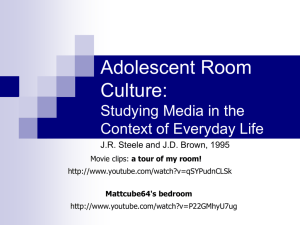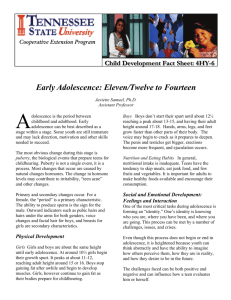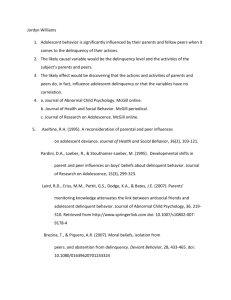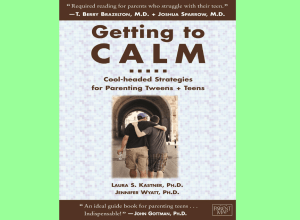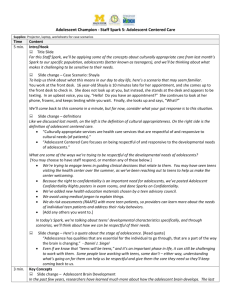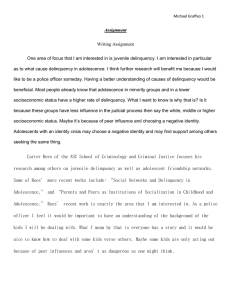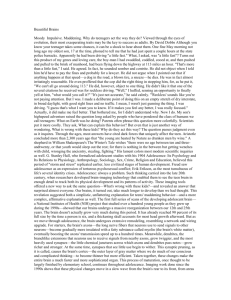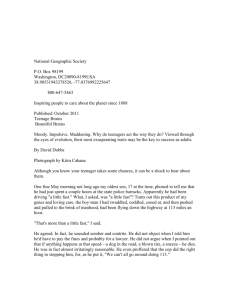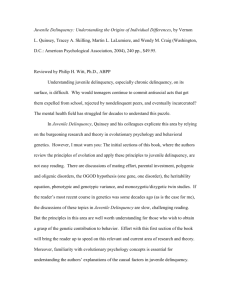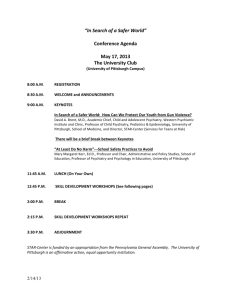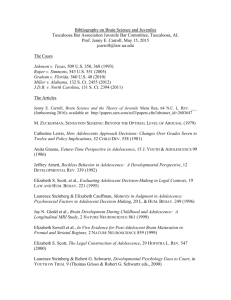Teen Culture - WordPress.com
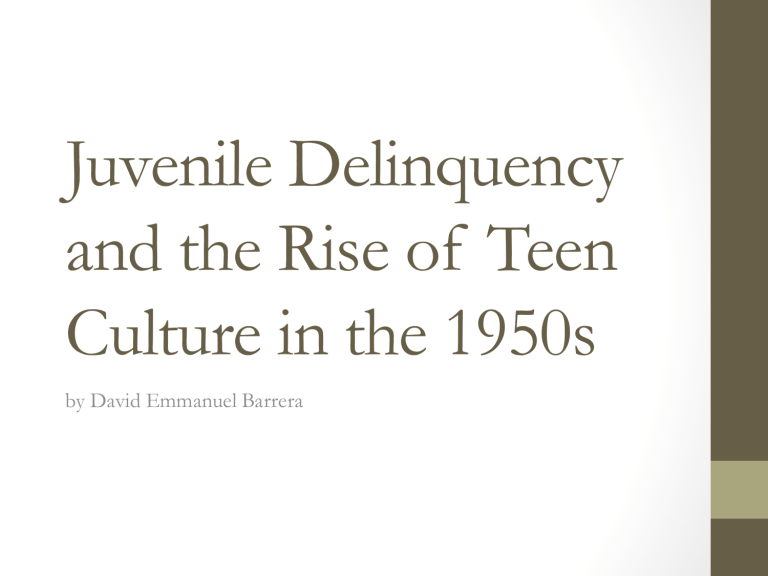
Juvenile Delinquency and the Rise of Teen
Culture in the 1950s
by David Emmanuel Barrera
Modern Age: Turn-of-the-Century
American Culture and the Invention of
Adolescence (2008)
“Although adolescence was not part of the popular lexicon until the turn of the century, its roots go back well into the early nineteenth century, most recognizably in popular recapitulationbased notions of childhood…The invention of adolescence was greatly informed by [these works] and in particular their use of recapitulation as a way of explaining the ‘savage’ behavior of the child and, perhaps more important, as a way of essentializing this behavior as not only biological but also evolutionary.”
-Kent Baxter, p. 8-9
Brief Look at the late-1940s
• The economic boom of postwar America brought optimism and euphoria for American teens.
• While Baxter argued how the turn of the century introduced the idea of adolescence, the late-1940s can be seen as the emergence of a teen culture
• The term teenager had not even been used until the ‘40s.
• In Flappers 2 Rappers: American Youth Slang (1996), Tom Dalzell states that it was “a word waiting for a concept.”
• Teens began to adopt a language, using words such as “groovy cats,”
“fly chick,” “jerk,” “square,” “geek,” “smooching,” “angel cake,” “in the groove,” and the most popular, “hip” – much were taken from Black jive talk and jazz on the radio.
• Cars became a staple for teen leisure. U.S. annual car production increased from 83,7000 in 1945 to 2,156,000 in 1946, and continued to increase dramatically until the end of the decade.
• Hollywood film’s female actresses embodied an ‘American look,’ defining a model of beauty for teenage girls.
Adolescent Character and
Personality (1949)
• With the imminent rise of teen culture in the late-1940s there was an increased want in understanding adolescents on both the psychological and sociological level.
• Such could hopefully bear reason to why teens acted the way that they did, talked the way they talked, as if they were new, and almost alien to society.
• “Recent studies of adolescents have emphasized the fact that boys and girls in their teens have a culture of their own with moral standards and with moral pressures behind those standards. This culture has been called the ‘adolescent peer culture.’ Boys and girls, desiring the approval of their age mates, follow the fashions of the peer culture in morals, dress, and speech; and the moral standards and practices of the adolescent peer culture are probably an important factor in character formation.”
McCarthyism / Paranoia
• February 9, 1950, junior senator of
Wisconsin Joseph McCarthy claims that there are exactly 205
Communists in the American government. This can be seen as the start of a 1950s American culture characteristic of paranoia and containment.
• In edition, FBI director J. Edgar
Hoover’s support for McCarthy only increased paranoia within the public sphere.
• These actions on the governmental level were internalized into how
Americans interacted with one another, and namely, how the supposed rise of teens was seen as a viable threat to ‘containment.’
Benjamin Fine’s 1,000,000
Delinquents (1955)
• Coined the term “JD” – juvenile delinquent, as if both were synonymous with each other.
• Claimed that since Attorney
General Herbert Brownwell predicted that there would be
1,000,000 delinquents by 1954
(and he was correct?), then it would only reach to more than
2,000,000 by 1960.
• This number would include highschool dropouts, vandalism, torture, and murder, all done for kicks because they all of the teenagers were meddling JDs (not juris doctorates).
A Cycle of Outrage (1986) by
James Burkhart Gilbert
• “During the 1950s and particularly from 1954 to 1956,
Americans worried deeply about a rise in juvenile delinquency.
The Attorney Generals’ Committee and the Children’s Bureau had done much to alert the public to the delinquency problem, but…Radio and television specials, newsreels, feature films, magazine articles, and newspapers examined delinquency as if it were something altogether new in this period of American history.”
• “A poll taken by the Roper organization in 1959 suggested that delinquency was viewed more seriously than open-air testing of atomic weapons or school segregation or political corruption.
On the other hand, Gallup polls throughout the mid-1950s placed delinquency at the bottom of ‘the most important problems’ in American society. Nevertheless, closer examination of results of various polls suggest a rise and fall in opinion.”
Treatment of the Delinquent
Adolescent (1954)
• “The adolescent in need of placement has usually experienced intense rejection from his family, either because of his own personality difficulties or because of the disturbances of other members of his family; typically, of course, it is the result of the interaction of negative factors in the parent-child relationship.
The child responds to rejection by his family with anxiety and hostility; these feelings may be expressed in overt hostile acts, or they may take the form of destructive fantasies that must usually be rigorously repressed.”
• A want to understand juvenile delinquents at the psychological level, asking questions such as, why such behavior arises, what can be done to treat them, and what public, domestic, or psychological impulses are the cause?
The Gang: A Study in Adolescent
Behavior (1958)
• “Each age and each society tends to look upon its young with mingled and troubled feelings. Aside from the deep and powerful attachments with which the life-giving generation regards its successor, there are the equally profound feelings of concern, anxiety, and even resentment, towards the young who are said to represent our ‘best hopes’ for the future. They are, in fact, our only hope.”
• “In the kind of world which children, and particularly adolescents, develop, there are powerful psychological forces in operation…In the first place, there are powerful psychological urges and strivings on the part of the young person to emulate some desired adult role. There is a considerable play-element involved in this process, and for the very young, these psychological factors are almost entirely involved in the play activity of the child.”
Teen Culture – Adult
Fantasy, Adolescent
Living
High School Life
• High school was where teens spent the majority of their time, and where they also learned how to engage with the world around them.
• Heightened desire for boys to pick up sports, especially football. Such were seen as the school leaders. Mixed messages though from parents since most wanted their children to excel academically, but desired them to be the most popular more than anything else.
• Girls equivalent was cheerleading, which, again, reiterated a societal want for young women to have their good looks to be accepted. Was once a coeducational activity, but became an exclusively feminine school activity.
• Notion of competition in school was instilled into the youths in high school – a location where teens were supposed to read books and such, but were shaped by their peers and influences.
Dating and Sex
• “The economy of the date was unchanged: the boy asked, the boy paid – whether it was for Cokes or orchids. The boy provided the transportation. The girl paid for her clothes and grooming since her chief economic responsibility was to look good. The date…was an act of ‘consumption,’ a public act.
Boys and girls alike wanted not so much the company of a particular person, but to be seen in the company of a particular person.”
• Different partners was the mark of success in the 1920s, ‘30s,’ and ’40s, but not in the 1950s. Rather, going steady was seen as the pinnacle of teenage dating.
• Double standard was in place: Boys had to ‘do it,’ and girls had to refrain from ‘it.’
Racial Integration
• 1954: Supreme Court decision in Brown v.
Board of Education set aside the 1896 ruling of “separate but equal.” Racial segregation in schools was unconstitutional.
• Though, in Little Rock, Arkansas, in 1957, the moving of 9 Black students into Little
Rock’s Central High School was met with fear by white parents.
• Govenor Orval Faubus called the
National Guard in wanting to prevent violence on the streets – or more so, to not let the Black students enroll.
• Student Elizabeth Eckford was met with threats, screams, and callings of “Lynch her!”
• All students graduated with the exception of one.
Rock & Roll
• Influence from African-American music, namely the Blues.
• Coined by DJ Alan Freed, and refers to sex.
• Television and radio extended
Rock & Roll’s reach.
• By the end of the decade, labels such as “country,” “pop,” and
“R&B” were iconic.
• Because of racial prejudice, Elvis was one of the first crossover artists to popularize Black music and make it palatable for the White
American youth.
• Became a form of identity and pleasure for teens.

